Contemporary JR East Limited Express Trains
A “Limited Express” is an express train that stops mainly at major stations, typically has partly or all-reserved seating, and usually requires an extra fee beyond the base fare between two stations charged for other trains. The actual Japanese name (特別急行, torokubetsu kyūkō, abbreviated to tokkyū) translates as “special express”, but these are commonly known in English as “limited express” trains. Intercity trains (aside from Shinkansen) operating beyond commuting distance are typically limited express trains. Limited express trains have the most variety of any JR East equipment aside from a few unique designs, and are visually distinct from commuter equipment.
On their website, JR draws a distinction between “kyūkō”, meaning express, and “tokkyū”, meaning limited express, but it’s a very vague one. Much of the equipment identified here appears to be used for both kinds of service, and to be more commonly downgraded to express service as it gets older.
The following are some typical JR East limited express trains, mostly those found in the vicinity of Tōkyō. Due to the number of these trains, this material has been broken up into several pages. This page focuses on more modern designs, the Older JR East Limited Express page covers the 18x and 48x series trains, some of which remain in use, and the Joyful Trains page includes equipment that is primarily used for charters (which is sometimes lumped in with Limited Express equipment).
251 Series (Super View Odoriko)
The 251 series of DC EMU is a JR East train used on the Tokaido Main Line, originally introduced in 1990 and refurbished in 2002. The train is operated in 7, 10 and 10+5 car sets. The train is capable of a top speed of 120 kph.
The equipment is used on:
- Super View Odoriko - Tōkyō or Ikebukuro to Izukyū-Shimoda
- Home Liner Odawara (weekdays) - Shinjuku to Odawara (evening train, outbound)
- Ohayō Liner Shinjuku (weekdays) - Odawara to Shinjuku (morning train, inbound)
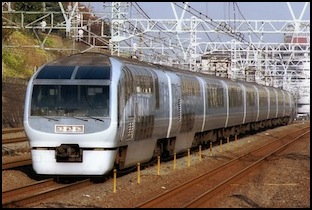
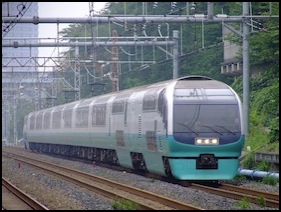
251 in original color (2001), and new color (2007)
Photographers: Yaguchi, and Linearcity
253 Series (Narita Express, original) and 253-1000
The 253 series of DC EMU was a JR East train used exclusively for express service between Narita airport and destinations around Tōkyō, known as N’EX or the Narita Express. Originally introduced in 1991 and replaced in 2010 by the E259. The train was formed of 3 and 6-car sets, and later 12-car sets, with up to 12 cars per train. A total of 111 cars were built. The train is capable of a top speed of 130 kph.
After retirement in 2010, the two most recent sets (which had substantial technological improvements over the older cars) were upgraded, repainted in a new scheme and reclassified as 253-1000, and used on joint Nikkō/Kinugawa limited express services in conjunction with the Tobu railway. Two other sets were sold to the Nagano Electric Railway (and reclassified as their 2100 series) for use on a limited express service. The remaining cars appear to have been scrapped.
Note: in addition to the two JR East Narita Express trains there is another railway, the Keisei Electric Railway, that recently introduced express service between Narita and Keisei's Ueno station, north of JR's Tōkyō station, under the name Skyliner.
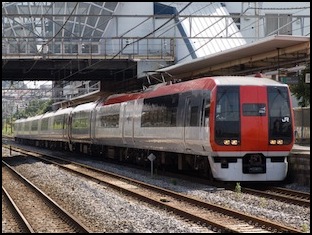
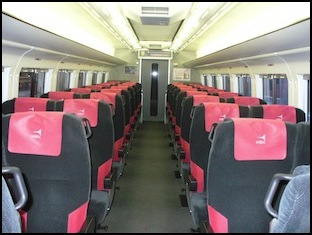
253 (2008), and 253 Normal Car Seating
Photographers: LERK, and l,t,d,express
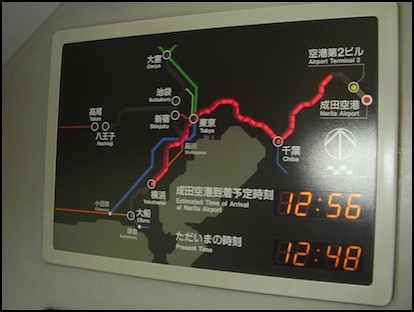
Narita Express Route
Photograper: WhisperToMe
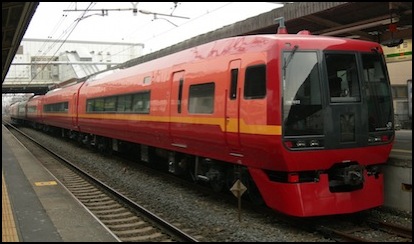
JR East 253-1000 at Hasuda Station (2011)
Photographer: Rsa
255 Series (Bōsō View Express)
The 255 series of DC EMU is a JR East train used for service on the Bōsō Peninsula, on the east side of Tōkyō Bay. Introduced in 1993, the train consists of 9 cars, with four motor cars per train. It is capable of a top speed of 130 kph.
Services using this equipment include:
Shiosai: Tōkyō to Chōshi
Home Liner Chiba - Shinjuku or Tōkyō to Chiba
Wakashio - Tōkyō to Kazusa-Ichinomiya or Awa-Kamogawa (both in Chiba)
Sazanami - Tōkyō to Tateyama (9-car sets)
View Kaiji - Chiba to Ryūō
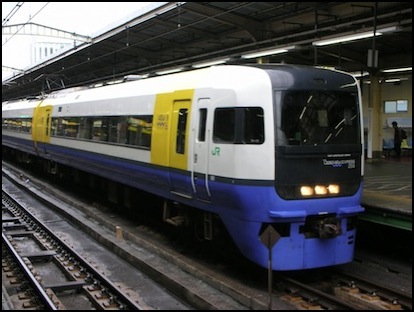
255 (2006)
Photographer: Kone
E257 Series (various services)
The E257 series of DC EMU is a JR East train. The original E257-0 was introduced in 2001 to replace 183 and 189 series equipment, and used in 2, 5, and 9-car sets. The E257-500 version in 2004, also to replace 183-series equipment, and is used in 5-car sets. The E257-500 also has doors at both ends, unlike the E257-0. The train is capable of a top speed of 130 kph.
The E257 is one example of Hitachi’s A-train design, which is used in various configurations by numerous other railroads, including other JR Group members, private railways, and overseas operators. The A-train uses a modular design, and variations are used in limited express and commuter service.
E257-0, Chuo Main Line:
Azusa - Chiba or Shinjuku to Matsumoto or Minami-otari (all via Shinjuku)
Kaiji - Shinjuku to Kōfu, in Yamanashi prefecture (using 9 or 2+9-car sets)
Chūō Liner - Tōkyō or Shinjuku to Hachiōji or Takao (using 9 or 2+9-car sets)
Ōme Liner - Tōkyō to Ōme (9-car sets)
E257-500, Bōsō Express:
Sazanami - Tōkyō to Tateyama (5-car sets)
Wakashio - Tōkyō to Kazusa-Ichinomiya or Awa-Kamogawa (both in Chiba)
Shiosai - Tōkyō or Shinjuku to Chōshi
Ayame - Tōkyō to Chōshi (via Narita?)
Ohayō Liner Zushi - Zushi to Tōkyō
Home Liner Zushi - Tōkyō to Zushi
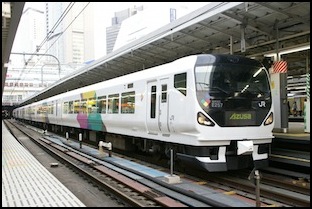
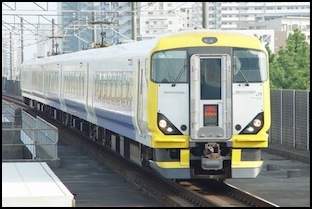
E257-0 Azusa (2008), and E257-500 Sazanami (2006)
Photographer: D A J Fossett (both)
E259 Series (Narita Express, new)
The E259 series of DC EMU is an aluminum-bodied JR East train, which began use in late 2009, and will gradually replace all of the 253-series trains used for JR East’s Narita Express. The train consists of 6-car sets, which can be linked to form a 12-car train, with a gangway between the linked sets. Like the E233, it is equipped with redundant systems for reliability. The train is capable of a top speed of 130 kph, with acceleration of 2.0 km/hr/s, and deceleration of 5.2 km/hr/s.
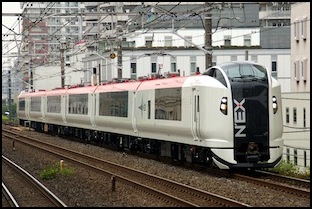
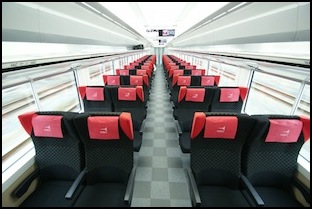
E259 (2009), and E259 Standard Class interior (2009)
Photographers: Sui-Setz, and D A J Fossett
E351 Series (Super Azusa)
The E351 series of DC EMU is a JR East train. Introduced in 1993 (JR’s website says 1994), the train consists of 4 and 8-car sets, which can be linked to form a 12-car train, with a gangway between the linked sets. Like the E233, it is equipped with redundant systems for reliability. The train is capable of a top speed of 130 kph.
The train features a “pendulum” tilting mechanism, to allow it to operate faster around curves by leaning into them.
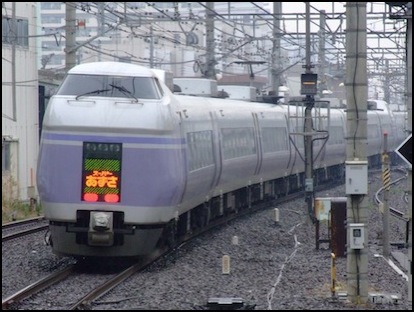
E351 (2006)
Photographer: LERK
651 Series (Super Hitachi)
The 651 series of AC/DC EMU is a JR East model, introduced in 1989 to replace 485-series equipment. The train operates on both 1,500 Volt DC and 20,000 Volt AC (at 50 Hz, so it can be used only in Eastern/Northern Japan). The train is capable of a top speed of 130 kph.
The train is formed of 7 and 4-car sets, and is used on Super Hitachi service from Ueno to Iwaki (212 km from Ueno) and Sendai (363 km from Ueno). This equipment is also used on some Fresh Hitachi services. The Super Hitachi service is described as a “business express”.
The “Hitachi” name comes from the city (and surrounding region) of Hitachi, located on the Pacific coast of Japan north of Tōkyō, on the Jōban Line, 149 km from Ueno Station.
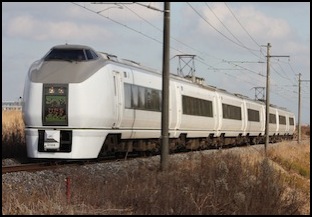
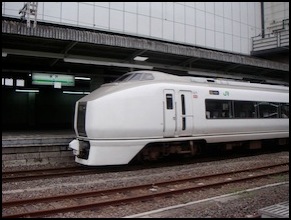
651 (2007), and at Mito (2005)
Photographers: TC411-507, and っ
E653 Series (Fresh Hitachi)
The E653 series of AC/DC EMU is a JR East model, introduced in 1997 to replace 485-series equipment. The train operates on both 1,500 Volt DC and 20,000 Volt AC (at either 50 or 60 Hz, so it can be used in both Western and Eastern/Northern Japan). The train is capable of a top speed of 130 kph.
The train is formed of 7 and 4-car sets, and is used on Fresh Hitachi limited express service from Ueno to Iwaki (212 km from Ueno). The four-car sets have an orange livery, but the seven car sets have red, blue, yellow and green versions (apparently the colors have no specific meaning other than denoting the manufacturer of a specific train-set). The Fresh Hitachi is described as a “business and tourist express”.
The E653 was, according to the manufacturer, developed by JR East to be it’s replacement equipment for earlier limited-express equipment. It utilizes the same “double-skin” hollow extruded aluminum body construction as the 700 series Shinkansen, where the interior of the skin is grooved to allow the attachment of modular interior structures, allowing the train to be refurbished without affecting the exterior structure. The double skin also serves to reduce noise inside the train. See Hitachi’s “New Technologies for Railway Trains” (PDF).
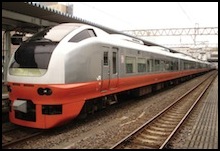
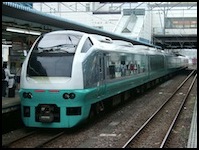
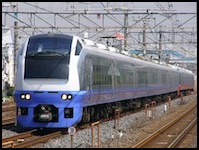
E653 4-car orange set (2007), 7-car green set (2008), and 7-car blue set (2003)
Photographer: Rsa, LERK, and Chabata_k
E655 Series (Nagomi, Imperial Train)
The E655 AC/DC EMU is a JR East model, introduced in 2007. The train operates on both 1,500 Volt DC and 20,000 Volt AC (at either 50 or 60 Hz, so it can be used in both Western and Eastern/Northern Japan). The train uses an aluminum alloy body, painted in an iridescent finish, and is capable of a top speed of 130 kph.
Although wikipedia lists it among the limited expresses, this isn’t strictly true. This is a special train of five cars (just one set exists) named Nagomi, available to be chartered, and used for State visitors who need secure transportation along Japanese rail lines. There is a sixth car, dedicated to use by the Emperor, and addition of this car makes the set into the “Imperial Train”. The train, except for the Imperial car (numbered E655-1) is housed at the Oku maintenance depot. The Imperial car itself is housed at the Tokyo General Rolling Stock center.
This trainset is covered more completely on the Joyful Trains page.
Additional References
Some of the information provided here came from the Wikipedia articles linked above, while other details were compiled from print and web sources. Among these were:
Taking the Train in Japan, from Japan-Guide.com - A travel website with information about rail travel.
New Technologies for Railway Trains (PDF), Hitachi Review, Vol. 48 (1999), No. 3, pg. 134.
JR East’s list of Joyful Trains (Japanese website).
Japanese Wikipedia page for the Kira Kira Uetsu.
Japanese Wikipedia page for the Oku Vehicle Center.
Japanese Wikipedia page for Tokyo General Rolling Stock Center.




